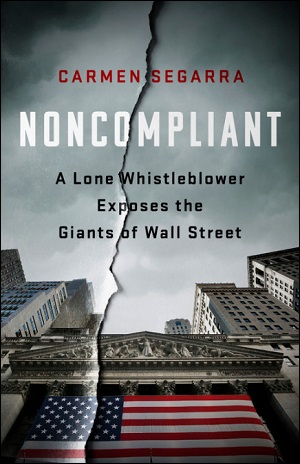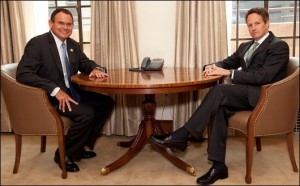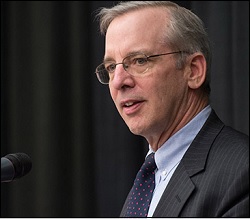By Pam Martens: March 11, 2019 ~
 The underlying theme that Wall Street’s Federal regulators have become whores for the industry permeates most of the well-researched books that have been written about Wall Street over the past decade. But no book has connected the dots to the nuances and subtleties of how this whoring works as effectively as Noncompliant: A Lone Whistleblower Exposes the Giants of Wall Street.
The underlying theme that Wall Street’s Federal regulators have become whores for the industry permeates most of the well-researched books that have been written about Wall Street over the past decade. But no book has connected the dots to the nuances and subtleties of how this whoring works as effectively as Noncompliant: A Lone Whistleblower Exposes the Giants of Wall Street.
Written by Carmen Segarra, the petite lawyer turned bank examiner turned whistleblower turned one-woman swat team, the 340-page tome takes the reader along on her gut-wrenching workdays for an entire seven months inside one of the most powerful and corrupted watchdogs of the powerful and corrupted players on Wall Street – the Federal Reserve Bank of New York. (The days were literally gut-wrenching. Segarra reports that after months of being alternately gas-lighted and bullied at the New York Fed to whip her into the ranks of the corrupted, she had to go to a gastroenterologist and learned her stomach lining was gone.) She soldiered through her painful stomach ailments and secretly tape-recorded 46 hours of conversations between New York Fed officials and Goldman Sachs. After being fired for refusing to soften her examination opinion on Goldman Sachs, Segarra released the tapes to ProPublica and the radio program This American Life and the story went viral from there.
The book exquisitely confirms, from a Wall Street veteran educated at Harvard, Columbia and Cornell Law, what Wall Street On Parade has been telling our readers for years – the New York Fed is at the core of Wall Street’s corrupt model. (See “Related Articles” below.)
In a nutshell, the whoring works like this. There are huge financial incentives to go along, get along, and keep your mouth shut about fraud. The financial incentives encompass both the salary, pension and benefits at the New York Fed as well as the high-paying job waiting for you at a Wall Street bank or Wall Street law firm if you show you are a “team player.” Segarra calls this process FUMU – “f**k up, move up.”
Segarra explains the benefits of keeping your mouth shut as follows:
“twenty days of vacation plus federal holidays, every other Friday off, and two pensions plans – a 401(k) with matching, plus an additional defined-benefits pension plan that would pay your full salary. And don’t forget the generous six-figure salary and five-figure bonus that was comparable to what you would receive at a private-sector bank outside the sales jobs areas. All that for a nine-to-five job – a true rarity in banking outside the secretarial and menial jobs. Plus, the freedom to add a second job on the side if you were willing to work and use your free time for it – of which you had plenty, as no one was expected to do much in the way of real or meaningful work. All you had to do was adapt to the Fed way of doing things.”
Two men who had adapted very nicely to the New York Fed’s way of doing things were William (Bill) Dudley, President of the New York Fed during Segarra’s time there and Michael F. Silva, Dudley’s former Chief of Staff turned bank regulator at the New York Fed. Silva is the man who asked Segarra to change her damaging report on Goldman Sachs and then fired her for insubordination when she refused to do so. (Segarra writes that she refused to do so because (1) it would be a lie and (2) as an attorney, she knew that she could be charged with evidence tampering.)
Dudley had spent two decades at Goldman Sachs before joining the New York Fed. According to the Federal Reserve Board’s annual report dated December 31, 2017, Dudley was making $476,100 in salary – the highest pay of any President at the 12 regional Fed banks. That’s also $76,100 more than the salary of the President of the United States.
Dudley retired from the Fed in June of last year. As we previously reported, by 2010 Dudley had amassed over $1 million in his Federal Reserve Retirement Thrift Plan according to his financial disclosure document. As we also reported in that article, Dudley’s wife, Ann Darby, was a former Vice President of JPMorgan – another Wall Street bank being supervised by the New York Fed. According to Dudley’s financial disclosure forms, his wife had holdings of more than $1,500,000 in deferred income accounts at JPMorgan Chase as well as between $250,000 to $500,000 in a 401(K) plan there. The Federal Reserve granted a waiver that allowed Dudley’s wife to receive $190,000 annually in payouts from JPMorgan Chase until 2021.
Michael F. Silva had also been Chief of Staff to Tim Geithner, the President of the New York Fed prior to Dudley. Geithner epitomized the FUMU model. After presiding over the toxic buildup that led to the greatest Wall Street collapse since the Great Depression, Geithner was named Obama’s Secretary of the Treasury where he presided over the greatest taxpayer bailout of Wall Street in U.S. history.
While Geithner and Silva were overseeing the New York Fed, Citigroup entered a death spiral in 2007 and 2008 as a result of obscene executive pay, off balance sheet debt and gross mismanagement of its far flung enterprises. Geithner’s appointment calendar shows an unseemly coziness with Citigroup, indicating that he held 29 breakfasts, lunches, dinners and other meetings with Citigroup executives as it spun out of control.
Geithner not only hosted Citigroup CEO Sandy Weill to lunch at the New York Fed, but on January 25, 2007, Geithner brought his teenage daughter to the lunch. Geithner’s appointment calendar shows his daughter sharing his chauffeured car to work with her father and accompanying him at his lunch with Weill. A few months later, on May 17, 2007, Geithner joined Weill for breakfast at the expensive Four Seasons.
Ron Suskind’s book, Confidence Men, was published in 2011. It indicates that Geithner ignored a directive from President Obama to wind down Citigroup as it was teetering toward becoming a 99 cent stock. Instead, what we have subsequently reported is that Geithner oversaw the massive government bailout of the derelict bank which included $45 billion in government equity infusions; asset guarantees of over $300 billion; and $2.5 trillion in secret revolving loans to Citigroup for more than three years through the New York Fed – much of which was at a loan interest rate of less than 1 percent as the bank charged its struggling credit card customers double-digit interest rates.

Michael F. Silva (left), Chief of Staff to Tim Geithner (right), President of the Federal Reserve Bank of New York During the 2008 Financial Crisis (Source — London Bullion Market Association)
Silva’s LinkedIn profile also has a curious job listed. It says that he was a “Federal Reserve Advisor to the Central Bank of Iraq” from 2003 to 2004. That’s not really something one should be bragging about. Vanity Fair reported in 2007 that “between April 2003 and June 2004, $12 billion in U.S. currency – much of it belonging to the Iraqi people – was shipped from the Federal Reserve [Bank of New York] to Baghdad.” The magazine further reports that $9 billion of that money ended up going missing “unaccounted for, in a frenzy of mismanagement and greed.”
“Mismanagement and greed” could equally describe the culture at the New York Fed as laid out by Segarra in her book.
Silva, according to his bio, in 2004 “received the Department of Defense Joint Civilian Service Medal and the Secretary of the Treasury’s Honor Award, both for his service in Iraq as a coalition advisor to the Central Bank of Iraq.”
Today, Silva has further moved up the corporate legal ladder. According to the web site of the large international law firm, DLA Piper, Silva is the (wait for it) Chair of its Financial Services Regulatory Practice. DLA Piper, by the way, has served as outside counsel to Goldman Sachs on numerous deals.
If the Democratic leadership of the House Financial Services Committee is smart, it will reopen the Senate’s aborted inquiry into the New York Fed’s labyrinthine conflicts of interest in supervising Wall Street and make removing that supervisory role a core component of the Democrat’s 2020 platform. Senator Bernie Sanders’ platform can certainly be expected to continue the accurate battle cry that “the business model of Wall Street is fraud.”
Related Articles:
U.S. Senate Tries Public Shaming of New York Fed President Dudley
New York Fed’s Answer to Cartels Rigging Markets – Form Another Cartel
Is the New York Fed Too Deeply Conflicted to Regulate Wall Street?
Relationship Managers at the New York Fed and Citibank: The Job Function Ripe for Corruption
New Documents Show How Power Moved to Wall Street, Via the New York Fed
Fed Minutes Reveal a Dangerous Power Grab by New York Fed
Libor Scandal Grows: Barclays Banged On the Door of the New York Fed 12 Times
Trading Floor of the Federal Reserve Bank of New York; In Photos, Over the Years


